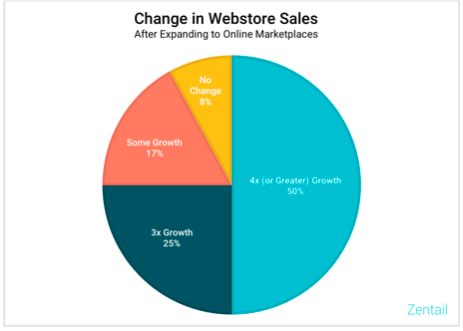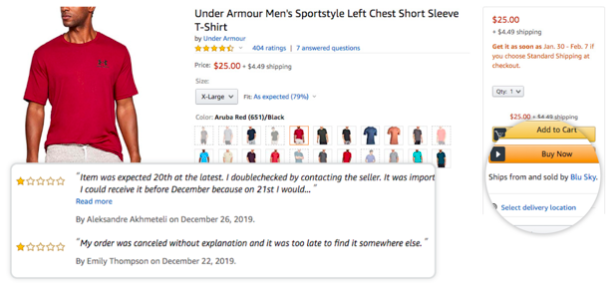Ecommerce Website vs. Marketplace: 5 Reasons for Selling on Both

The Shopify-Walmart Marketplace partnership is the latest reminder that webstores and marketplaces aren’t mutually exclusive. In fact, some digital-native brands, like Brooklinen, can be found selling on Amazon today, after years of championing first-party DTC models.
The reality is, if you’re not selling on a third-party marketplace, then you’re missing out on a big opportunity. While webstores are essential for building authority around your brand, marketplaces are critical for getting your products off the ground and in front of the masses.
This blog will dig deeper into how times have changed and how you can harness the strengths of each channel to grow the success of your business.
5 Reasons Why You Shouldn’t Ignore Third-Party Marketplaces
This past year alone has been a transformative one. Ecommerce adoption is said to have accelerated 10 years ahead, with market share up 11% in the U.S. after just eight weeks. That’s the same amount of growth it achieved over the previous decade.
Retail giants like Amazon and Walmart are driving a significant amount of that growth. Amazon posted its best performance in at least six quarters, while Walmart showed signs of surpassing eBay as the second largest ecommerce retailer in the U.S. behind Amazon.
Sellers who are active on these marketplaces stand to benefit from this surge in online shopping by way of affiliation. Aside from this, there’s lots of other evidence pointing to the fact that marketplaces can be helpful to the growth of your brand (and webstore). Here are some facts that shouldn’t go ignored.
1. Amazon is the Number One Search Engine
Amazon surpassed Google years ago and now owns 55% of all product searches online. The company has 80% market share in many categories, according to a report by Jumpshot, and is only likely to grow in dominance.
Selling on Amazon means being able to meet your customers where they already shop. It means exposure to over 206 million monthly visitors and access to an advanced, highly personalized search engine.
Rather than relying on your ability to scale marketing or stretch your ad spend, you can harp on the reputation Amazon has already built. Sixty-five percent of consumers even say they’re comfortable purchasing from merchants they’ve never heard of before when shopping on marketplaces, according to DigitalCommerce360.
Whether out of convenience, habit or trust, buyers are regularly visiting Amazon.com. You can either meet them there or hope that they return to your site to complete their purchases.
2. 92% of Sellers Have Seen Website Growth After Being on Marketplaces
One common concern that sellers express is the fear that marketplaces will cannibalize their website sales by drawing attention away from their site listings. But the record shows that this isn’t necessarily the case.
A recent study by Zentail found that a vast majority of SMBs saw some type of growth in their webstore sales within the first year of launching to a marketplace. Twenty-five percent tripled their sales, while 50% quadrupled their sales (if not more).
Those who saw the greatest uptick in website sales had, on average, a total of four marketplaces after one year. The greatest growth came after being on those channels for at least six months and generating a flow of at least 500 monthly orders on those channels.
The pendulum swings in both directions: it’s not uncommon for marketplace sales to spike on products that are driving the most traffic to your website. This speaks to buyers’ tendency to check marketplaces for better prices and a full list of options, even after visiting a brand’s site.
“[Customers are] going to purchase where they want to purchase,” explains Daniel Tejada from Amazon consultancy firm, Straight Up Growth. “But if you’re giving yourself the ability to be found on those other marketplaces, it really gives you a chance to take as much market share as possible through product discovery there.“
3. Selling on Multiple Channels Reduces Concentration Risk
It goes without saying that you never want to be without an active sales channel—but many sellers found themselves in this position when the COVID-19 pandemic hit. Suddenly, buyers were slashing their discretionary spending and hawking essential items from their go-to sites.
Sellers were hit hard on multiple fronts; not only did demand fluctuate overnight, but supply chains were also severely disrupted. Both Amazon sellers and website owners faced a lot of uncertainty in their futures.
But several sellers came out relatively unscathed, each of whom attributed his or her immunity to their multichannel approach to ecommerce. Multimillion-dollar appliance company McCombs Supply, for example, reported a 20% lift in Walmart Marketplace sales and an overall 11% lift in online sales in March. Webstore sales accounted for a third of sales during that period, while eBay brought in another third.
“People are finding McCombs through all sorts of organic searches,” said Vice President Ken McCombs III in an interview with Zentail. “The work we put into building our keywords, website and other channels is really paying dividends right now.”
Whether in times of crisis or in normal times, diversification can prevent over-reliance on any one sales channel. In addition to this, marketplaces can offer low-cost testing grounds for keeping a pulse on market conditions or engaging a new type of buyer outside of the ones who already frequent your site.
4. Marketplaces Are Essential for Getting Ahead of Competitors
Truth be told, your competitors are already selling on marketplaces. Whether in the form of direct competitors, cheap knockoffs or unauthorized resellers, competitors lurk in the most high-trafficked corners of the internet.
By sidelining your brand on your website, you risk losing buyers to those who are readily accepting their business elsewhere. Some buyers may not even know that they’re purchasing from a different seller when they buy your products off Amazon or Walmart Marketplace. On a highly competitive listing, like the one below, consumers may think that item is being directly shipped by your company and pin any poor customer experience on your brand.

Many marketplaces also work on a first-come-first-served basis. If you’re the first to list, you’ll enjoy the greatest control over the content of the listing. Not only this, but some marketplaces offer a brand registry (like Amazon’s Brand Registry or eBay’s Verified Rights Owner program) allowing you to seal off editing on your listing and/or retain buy box ownership, over other perks.
You’ll want to check who’s already selling your products where. Chances are, as brick-and-mortar stores make the move online, many will list their unsold inventory to marketplaces even though they lack proper authorization.
5. With the Right Tech, You Can Manage Both Easily
When all is said and done, managing multiple sales channels can be tricky for sellers who don’t have a system in place to handle:
- Product information management, to ensure that product data is properly formatted for each marketplace (and to prevent listing errors).
- Listing management for creating, editing and grouping (e.g., variation listings or product kits) listings on multiple marketplaces without having to repeat any work.
- Inventory syncs, to avoid overselling by updating inventory levels in near-real time.
- Inventory thresholds, to avoid overselling when you’re down to the last few items of your product .
- Multi-warehouse management for routing orders to the right warehouse and/or fulfillment centers.
- Analytics and forecasting, to understand your profitability across all channels; identify your best and worst-performing SKUs; and forecast demand from centralized data.
The good news is, solutions for these exist. SkuVault, for example, provides tight control over your supply chain. You can manage multiple suppliers and warehouses (including FBA and 3PLs) from one place, plus automate warehouse functions, like receiving, to meet marketplace standards for shipping and ODR.
SkuVault’s integration with Zentail also allows for easy management over your catalog. With AI-driven features, like SMART Types, Zentail is able to translate your product data for every channel and publish your listings in a few simple clicks. Together with SkuVault, you can avoid costly errors and sidestep issues that normally hamper a seller’s ability to sell beyond one channel.In Summary
We’re living in an age when the buyer’s journey is becoming more and more fragmented. Between webstores and marketplaces, buyers are taking an average of six touchpoints before making a purchase.
Today’s sellers are required to cast a wide net. They’re required to explore (albeit strategically) various avenues for bringing in revenue and drawing attention to their brands.
Luckily, onboarding to a new channel doesn’t have to mean two times the work. Software solutions exist today, specifically to help multichannel sellers automate tedious tasks and get started on the right foot.
Consider all that your business has to gain from branching out from its webstore. Don’t let old-school assumptions keep you from adapting and cause you to leave money on the table.